

Learning - Source: An OpenNews project. Learning data Gender, Twitter, and the Value of Taking Things Apart Jake Harris reverse-engineers Twee-Q to evaluate its use of data (and see if his ratio is as disappointing as Twee-Q says it is) Learning process Security for Journalists, Part Two: Threat Modeling By Jonathan Stray Jonathan Stray on how to protect yourself, your sources, and your scoop on sensitive stories Learning process Security for Journalists, Part One: The Basics Jonathan Stray on what every single person in your news org should be doing to secure the newsroom.
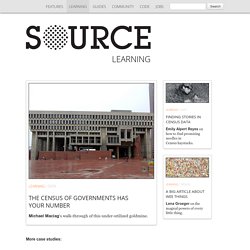
Sources and tools for data journalism. Credit: Thinkstock This is an edited version of a chapter from Data Journalism: Mapping the Future, published next week by Abramis academic publishing, republished with kind permission. Daniel Ionescu is managing editor of The Lincolnite, an award-winning local news site that experiments with data journalism. Data journalism: Mapping the future (RRP £15.95) is available at a reduced rate of £12 for Journalism.co.uk readers. Contact richard@abramis.co.uk for further information. Government Data Portal The central repository of public data relating to the UK is the HM Government Data Portal, which hosts more than 10,000 datasets from all central government departments, as well as a range of public sector bodies and local authorities across the country. Open Data Institute. What is open data?
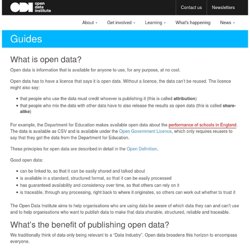
Open data is information that is available for anyone to use, for any purpose, at no cost. Open data has to have a licence that says it is open data. Without a licence, the data can’t be reused. The licence might also say: Digital portfolios for journalists: What are your options? Until recently, many journalists built their own sites to highlight and promote their work.
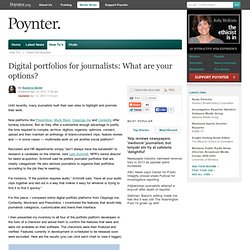
Now platforms like Pressfolios, Muck Rack, Clippings.me and Contently offer turnkey solutions. But do they offer a substantial enough advantage to justify the time required to compile, archive, digitize, organize, optimize, connect, upload and then maintain an anthology of brand-consistent clips, feature stories and — in some cases — multimedia work on yet another social platform? Recruiters and HR departments simply “don’t always have the bandwidth” to research a candidate on the Internet, said Lars Schmidt, NPR’s senior director for talent acquisition. Schmidt said he prefers journalist portfolios that are clearly categorized. He also advises journalists to organize their portfolios according to the job they’re seeking.
The Art Market for Dummies: Building a Data-Driven Explainer. By Jean Abbiateci, French freelance journalist and teacher at Lannion School of Journalism.
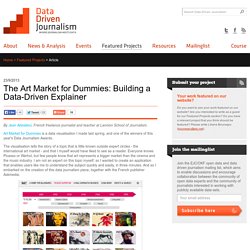
Art Market for Dummies is a data visualisation I made last spring, and one of the winners of this year's Data Journalism Awards. The visualisation tells the story of a topic that is little known outside expert circles - the international art market - and that I myself would have liked to see as a reader. Everyone knows Picasso or Warhol, but few people know that art represents a bigger market than the cinema and the music industry. I am not an expert on this topic myself, so I wanted to create an application that enables users like me to understand the subject quickly and easily, in three minutes. And so I embarked on the creation of this data journalism piece, together with the French publisher Askmedia.
Welcome. The Data Journalism Handbook. Lessons from the School of Data Journalism. Another busy year has passed since the first School of Data Journalism at the [International Journalism Festival in Perugia]( Last year, the [Open Knowledge Foundation]( and the [European Journalism Centre]( launched the [Data Journalism Handbook]( and this year, the two organizations were back organizing the festival within a festival.
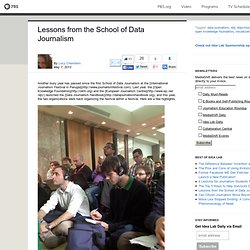
Here are a few highlights. Attendees of the School of Data Journalism at the International Journalism Festival in Perugia take notes. How sensor reporting helps journalists find data where none exist. Have you ever wondered how well your luggage is treated at the airport?
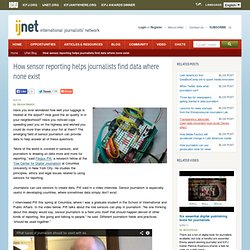
How good the air quality is in your neighborhood? Have you noticed cops speeding past you on the highway and wished you could do more than shake your fist at them? The emerging field of sensor journalism can provide data to help answer all of these questions. “More of the world is covered in sensors, and journalism is drawing on data more and more for reporting,” said Fergus Pitt, a research fellow at the Tow Center for Digital Journalism at Columbia University in New York City. He studies the principles, ethics and legal issues related to using sensors for reporting. Journalists can use sensors to create data, Pitt said in a video interview. I interviewed Pitt this spring at Columbia, where I was a graduate student in the School of International and Public Affairs. So far, sensors have predominantly been used in investigative reporting and to bring awareness to environmental issues such as air quality and noise.
Expert Tips for Making Better Infographics. While infographics are a great way to help readers understand complex topics, journalists should avoid the temptation to make information appear to be simpler than it is.
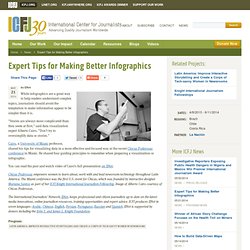
"Stories are always more complicated than they seem at first," said data visualization expert Alberto Cairo. "Don't try to oversimplify data or stories. " Cairo, a University of Miami professor, shared his tips for visualizing data in a more effective and focused way at the recent Chicas Poderosas conference in Miami. He shared four guiding principles to remember when preparing a visualization or infographic. You can read the post and watch video of Cairo’s full presentation on IJNet. Chicas Poderosas empowers women to learn about, work with and lead newsroom technology throughout Latin America. How to Build Data-Driven Maps. Toolkit for better and accurate reporting. Featured Published on April 29th, 2014 | by EJC This article was written by Farida Vis and originally published at The Conversation on 16 April, 2014.

Republished with permission. Last summer the World Economic Forum (WEF) invited its 1,500 council members to identify top trends facing the world, including what should be done about them. The WEF consists of 80 councils covering a wide range of issues including social media. The top three issues highlighted for 2014 concerned rising societal tensions in the Middle East and North Africa; widening income disparities, and persistent structural unemployment. MicroMappers « Supporting Disaster Response. With a Single Click! Verification Handbook: homepage. Verification Handbook: homepage. "In today's digital environment, where rumors and false contents circulate, journalists need to be able to actively sort out true, authentic materials from the fakes.
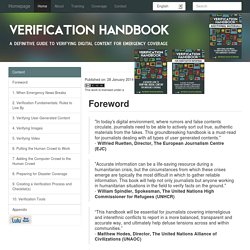
This groundbreaking handbook is a must-read for journalists dealing with all types of user generated contents. " - Wilfried Ruetten, Director, The European Journalism Centre (EJC) "Accurate information can be a life-saving resource during a humanitarian crisis, but the circumstances from which these crises emerge are typically the most difficult in which to gather reliable information. This book will help not only journalists but anyone working in humanitarian situations in the field to verify facts on the ground. " - William Spindler, Spokesman, The United Nations High Commissioner for Refugees (UNHCR)